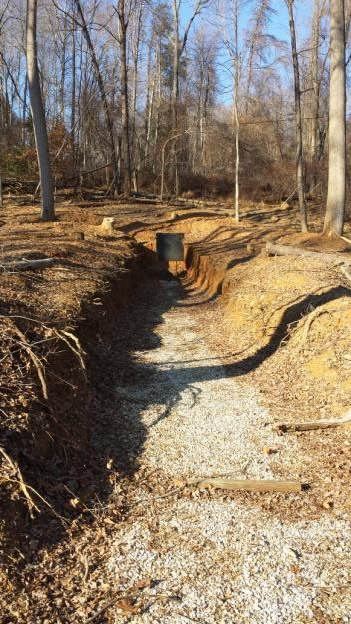Shotgun Patterning Range
The Shotgun Patterning Range is located behind Memorial Hall.

A target Holder is located at the end of the range.
See Range Rules, Shotgun Patterning Range, for specific restrictions.
Paper supply is provided by the AGC and located under the covered porch at the end of Memorial Hall.
Patterning for gun fit:
From the face of the target, measure exactly 16 yards and mark the spot. Why 16 yards? Because at this distance for every inch the pattern deviates from the point of aim a one-sixteenth-inch correction to the stock is necessary. Therefore, if the center of the pattern strikes 2 inches low, the comb of the stock must be raised 1⁄₈-inch to center it.
Shoot three shots at the same target, carefully aiming at the marked center. Don’t correct your aim or look at the bead(s). Be sure that the gun is mounted with the cheek firmly against the stock. This will establish a baseline, and generally will show how the stock fits. Use the tightest choke available and light target loads.
Unless there is a shooting problem, these aimed shots will normally superimpose one over the other. Carefully evaluate the target. Determine the patterns’ center, then measure the distance from it to the center aiming point. From this we can make our preliminary adjustments. Deviation left to right can indicate a too-low comb and/or a cast problem. Vertical deviation from the center indicates a too-high or too-low comb.
Correcting a too-low comb is easily done using strips of leather taped to the stock with plastic electrical tape. Stock length can be adjusted by adding a slip-on recoil pad or washers inserted between the butt plate and stock. Cast and a too-high comb are more difficult to achieve without actually altering the stock, and we’re not ready for that.
Traditional Patterning:
“How to Pattern a Shotgun”, By Chuck Hawks (http://www.chuckhawks.com)
Shotgun patterns are measured at 40 yards for all gauges, except .410 bore. .410’s are patterned at 30 yards. Patterning is a simple process, but time consuming due to all the counting required. Here is the correct way to pattern a shotgun.
1. Set a big piece of blank paper on a frame 40 yards from the muzzle. (Butcher’s paper cut into 48″ squares works well.)
2. Shoot at the center of the paper.
3. Draw a 30″ diameter circle around the center of the resulting pattern, so that it encloses the greatest number of holes.
4. Count the pellet holes in the circle. (It helps to mark the holes with a magic marker as you count them, so you don’t lose your place.)
5. Cut open an identical, unfired shell and count the pellets in the shell. (The actual number of pellets may vary from the theoretical number based on shot size and weight, so it is best to count them.)
6. Calculate the percentage of pellets that hit in the 30″ circle. (Divide the number of holes by the number of shot in the unfired shell.)
That is it; you have now officially patterned your shotgun. Of course, every shot varies, so ideally you should repeat the process 10 times and average the results. (Analogous to shooting a group with a rifle, rather than just one shot.) Your shotgun’s pattern percentage will vary if you change the shot size, the amount of shot in the shell or the hardness of the shot, so you need to pattern all the loads you actually shoot in a given gun.
Pattern percentages will usually (but not always!) go up if you increase the hardness of the shot, decrease the weight of the shot charge, buffer the shot inside the shell, or decrease the muzzle velocity of the shot charge. Pattern percentages will typically do down if you use softer shot, increase the weight of the shot charge or increase the muzzle velocity of the load. These generalizations primarily apply to traditional lead shot, your gun may vary.
The percentage of pellet strikes that constitutes what choke varies, depending on the source. Jack O’Connor gave these percentages in his Shotgun Book, which are typical:
• Full Choke: 70% or higher
• Improved Modified: 65%
• Modified: 55-60%
• Skeet No. 2: 55-60%
• Quarter Choke: 50%
• Improved Cylinder: 45%
• Skeet No. 1: 35-40%
• Cylinder: 35-40%
